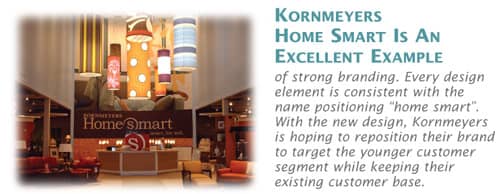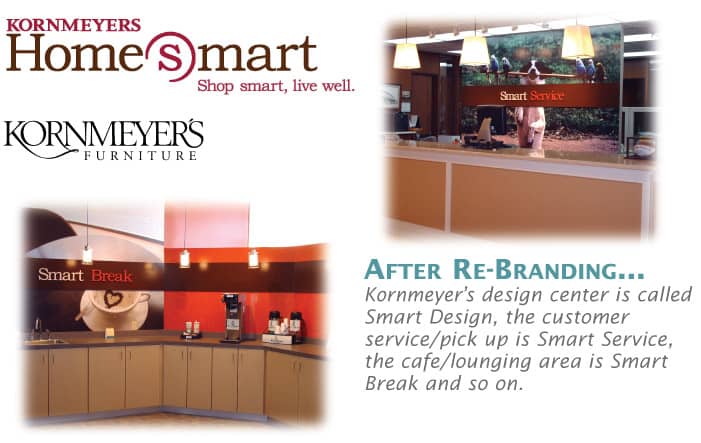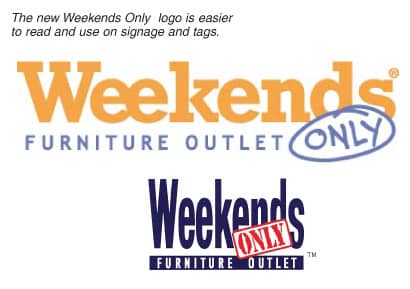Part 2: Now that you’ve uncovered your store’s essence, what next?
Strategic Branding by Martin Roberts
In the October/November issue of FURNITURE WORLD Magazine, we talked about uncovering what makes retail stores unique, that is, the process of identifying a store’s DNA. Then we discussed using that information to create strong brand identities.
Brand identity is the outward expression of what companies stand for, and is critical to creating a potent brand presence in the marketplace it serves. By helping the customer understand what makes your store stand out from the crowd, you create the brand power needed to attract and drive retail traffic, and stimulate sales.
Brand identity work represents a first step in the branding process. Let’s take a look at what happens next.
Brand Positioning
Harnessing brand power for positive results requires sound strategic thinking. Brand strategy affects everything a store does, and defining yours is worth the time invested. Think of your favorite football teams’ winning plays – these are the results of maneuvers planned well before players ever stepped onto the field.
Brand positioning is defined by the specific ways your store is perceived, in the context of your store’s competitive framework. Today, that not only includes the retailer on the other side of town, but also the online offerings from polished lifestyle purveyors like William Sonoma Home, Restoration Hardware, Crate and Barrel, etc.
If brand identity expresses the store’s DNA, then brand positioning might be thought of as the target customer’s interpretation of that identity. It begs the question: what is your store’s reason for being? Check your response by putting yourself in your customer’s shoes. Are you on the same page?
Survey furniture retailers and you’ll be amazed to learn how introspective the majority are when they respond to the question. Price, value, and selection, they all say. Wrong answer! Another perspective is needed: Consumers purchase home furnishings to enhance the way they live. Does your positioning statement reflect the consumer’s goal?

Walk into an Apple computer store and you experience firsthand the power of effective brand positioning. Witness technology as cool, universally appealing, and accessible. From its innovative name to the airy, glass and natural wood-filled retail space, the happy, trained store personnel and great products, Apple stores just make you want to be there. Who among us can resist sidling up to the Genius Bar?
Your retail brand needs to be relevant to your target audience, and encourage consumer loyalty in a hyper-competitive selling environment. Your brand strategy has to answer the question in a way that empowers the customer to achieve their lifestyle goals with the home furnishings products you are selling – in a retail environment that is welcoming, helpful, inspirational, and enjoyable to be in.
Branding Research
Branding research is a helpful tool for uncovering your target customer’s point of view. Customer perceptions may be examined through focus groups or other direct contact, where leading questions are posed. The purpose of branding research is to make sure that a store and its customers share a point of view.
When you do this research, be prepared to learn that your current positioning is outdated, as consumers are a dynamic force. Re-positioning your store brand is one way to remain vital.

Don’t forget that each touch point for the brand, including your storefront, interiors, signage, and product merchandising – as well as your online presence, direct marketing materials, and advertising – must readily convey the store’s positioning statement.
A brand must be evaluated and understood not only as it exists as a stand-alone brand, but also how it relates to competitors. How these perceptions differ among various groups of target consumers should also be determined.
Al Wight at Strategic Decisions supplied some key research terms that you should be familiar with before undertaking branding research:
1) Unaided first mention: When you think of a store selling furniture what store first comes to mind?
2) Aided awareness: Have you heard of ABC Furniture?
3) Brand preference/shopping consideration- If you were shopping for (furniture, carpet, etc.) what store would you shop first?
4) Brand attributes: What perceptions are associated with a brand and how strongly are they associated?
- Price level of merchandise carried.
- Quality of merchandise carried.
- Selection of merchandise.
- Carrying the brands of products that the target
consumer wants.
- Reputation for caring for customers and taking care of problems.
- Price and value for the money.
- Advertising that makes one want to shop there.
- Convenience of location.
- Exterior of the store.
- Interior of the store and ease of shopping.
- Knowledge and professionalism of salespeople.
- Store services such as delivery, financing, customer service, getting a salesperson when they need one, etc.
Evaluating a brand in the reality of a specific market is the key to leveraging that brand successfully. Unless you truly understand how your brand exists today to a high level of statistical certainty, it will be difficult to appropriately reposition that brand. If you try to position a brand inappropriately, for example, touting attributes that the market doesn’t believe are true, you can actually injure your brand identity.

Once you’ve put all the pieces together, you’re ready to start a conversation with your consumers.
Brand Voice
Branding provides a retailer with its most powerful tool, a voice with which to speak to the customer. It conveys a host of important messages, both practical and emotional.
For consumers at all economic levels, home furnishings purchases represent big, long-term investments, and most want to feel good about their dealings with a store before handing over their hard-earned cash. Use your brand voice to set the tone for these interactions, create a tagline that succinctly defines your positioning, and build an ambience in stores that makes shoppers want to spend time there.
Descriptive taglines are an excellent way to give voice to your store’s raison d’être, as well as to address consumer expectations. For instance, ‘Furniture + Design,’ the tagline GRID2 developed for Norwalk’s newest retail concept, provides important clues as to what the company offers its customers – before they enter the store. It’s clear that Norwalk is offering more than furniture. And equally important, the plus-sign graphic element, used in place of the word “and,” is expected to resonate with the store’s target customer: the savvy, hip, design-oriented shopper. Though the design service at another store might essentially be the same, using the tagline, ‘Affordable Custom Design,’ conveys a more straightforward approach, appealing to the consumer who values price over being known to her friends as a design maven.
This year, Kornmeyer’s in Baton Rouge became Kornmeyer’s HomeSmart. The name change provided an excellent springboard for the retailer’s new tagline: Shop Smart, Live Well. “The idea is extended to a nomenclature system which the customer encounters throughout the store, at various functional areas now labeled Smart Service, Smart Info, and Smart Buys,” says Susan Weingarten, senior associate and project director, GRID2. “It’s implied that the consumer is empowered to get the home décor results they want, with money left over for other things.”

Visual cues are equally essential to effective consumer communication. Typography, symbols, icons, and color – all represent the dozens of vehicles that may be used. Even distinct shapes in the typography, modern, traditional, or geometric styles, take on significance in the communication exchange. More shorthand for quickly capturing consumer attention.
Every visual and verbal cue is used to express the brand positioning.
Experience cues are becoming more meaningful at retail, too. Think of IKEA, the Scandinavian retailer known for its accessible designs and sharp pricing. Even the store cafeteria’s comfort foods support the brand positioning: it’s an easy, family-friendly place to shop.
With a strong brand identity and a host of other cues used throughout, any store brand’s main message can be easily understood and used to differentiate your store in a cluttered competitive environment.
Brand Promise
The store name, in particular, should be viewed as verbal shorthand for the brand’s promise. It is a key element to encourage and prompt shoppers to give the store a try. In fact, if a name can manage to evoke a sense of security on the part of the consumer, while the store delivers on its promise of satisfaction guaranteed, then the brand is a sure winner. Focus groups have shown that name alone can help to overcome shopper skepticism. Is your name worth remembering? “We estimate that we have 6 – 10 seconds to communicate what the business stands for and what it offers consumers, while they are driving by,” says Weingarten. “A name, with its visual treatment, is the first point of connection.”
For residents in suburban St. Louis, Weekends Only Furniture Outlet, founded by Dave Phillips in 1997, offers shoppers a chance to take advantage of significant deals. It is open only on Friday, Saturday, and Sunday. The graphic treatment of the word “only” was conceived to instill a sense of urgency for shoppers.
Passing the savings on from closeouts and truckload purchases in a limited window of opportunity is so successful that the operation now consists of five locations in metro St. Louis, with a recent opening in the Mid-Rivers area. It’s a unique but simple proposition in home furnishings retail and it works. Weekends Only delivers on its promise.
Branding is your platform for positive consumer relations. But did you know that effective branding benefits everyone associated with your business, from executives to part-time employees? That’s because branding clearly defines what your store stands for, internally as well as externally. So, your customer’s expectations become your store’s expectations. Now that’s getting everyone on the same page.
Martin Roberts is an internationally acclaimed design industry veteran, with over 40 years of credits for retail and product design. His most respected work is included in the permanent collection of the Museum of Modern Art in New York.
Throughout his career, Roberts has placed special emphasis on the role of branding and marketing in his work. In 1991, Roberts’ launched GRID2 International, a specialized design firm that incorporates scientific methodology to inform the design process.
With his staff of brand strategists, retail planners, art directors, graphic designers, web designers, environmental and industrial designers, Roberts leads his firm in interpreting brand DNA to the target consumer.
Roberts’ previous works included such nationally and internationally renowned corporations and brands as Bank of Boston, Barnes & Noble, Cartier, Chase Manhattan Bank, Coach, Duty-Free Shops, General Foods, Johnson & Johnson, K-Mart, Marriott International, Nestle, Perrier, Samsonite, Thomasville Furniture, Timberland, and Wal-Mart.
Before founding GRID2, Roberts’ professional affiliations included membership in The Royal Society of Arts (London), the Society of Industrial Designers, and the Institute of Store Planners. With a BA in Industrial Design Engineering and an MA in Design Systems, Roberts has also served as an adjunct professor of Design Management at Parsons School of Design.
Questions on any aspect of retail branding or store design may be directed to him at mroberts@furninfo.com.